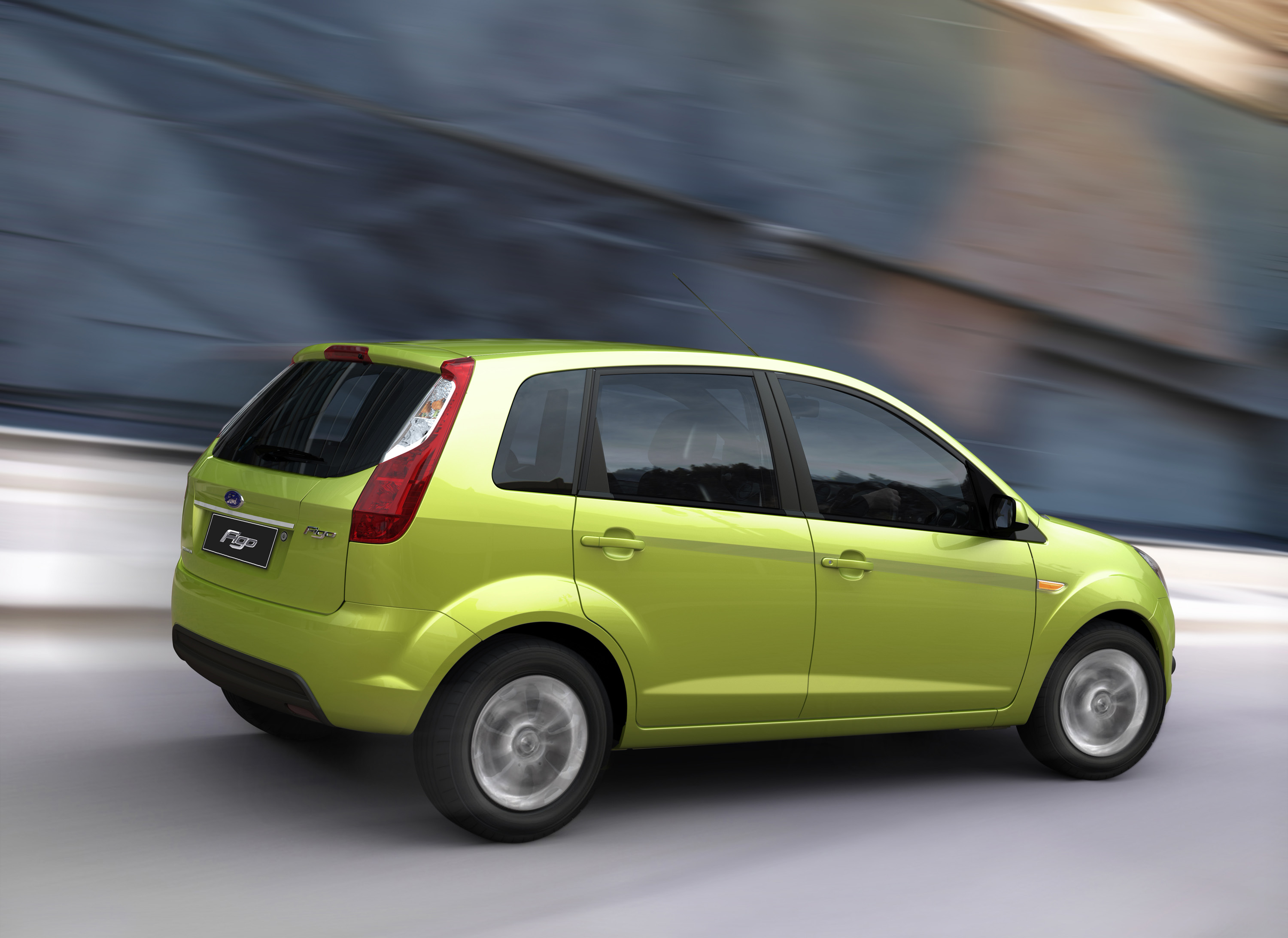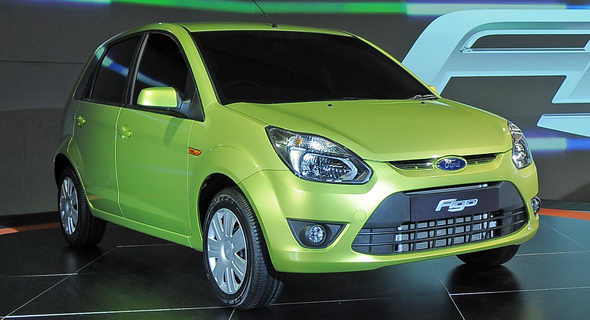By 2010, the sixth-generation (Mark VI) Fiesta had been introduced worldwide, including in the United States and Canada—making it the first Fiesta model to be sold in North America since 1980.

Ford Figo Interior Pictures

Ford Figo Awards - Ford Figo
The Fiesta was originally developed under the project name "Bobcat" and approved for development by Henry Ford II in September 1972. Development targets indicated a production cost US$100 less than the current Ford Escort. The car was to have a wheelbase longer than that of the Fiat 127, but with overall length shorter than that of Ford's Escort. The final proposal was developed by Tom Tjaarda at Ghia. The project was approved for production in autumn 1973, with Ford's engineering centres in Cologne and Dunton (Essex) collaborating.

ford figo picture
Ford estimated that 500,000 Fiestas a year would be produced, and built an all-new factory near Valencia, Spain; a transaxle factory near Bordeaux, France; factory extensions for the assembly plants in Dagenham, UK, and Saarlouis, Germany. Final assembly also took place in Valencia.

Ford Fiesta, Ford Figo
When Ford of Europe began to design the car, the design proposals were named Iris, Beta, The Deutschlander (from Ford's Cologne studios), Mini-Mite, and the Blue Car (from Ghia). Codenames for the Fiesta prototype included Torino, but it became Project Bobcat.

Ford Figo Car Models,

Ford figo still on top
The shortlisted names for the new car designed by the project Bobcat team (headed by Mr Trevor Erskine) were Amigo, Bambi, Bebe, Bravo, Bolero, Cherie, Tempo, Chico, Fiesta, Forito, Metro, Pony and Sierra. Despite more board votes for "Bravo", Henry Ford II personally overruled them and named the car "Fiesta". Several of the shortlisted names were later used on other cars, including "Sierra", which was introduced on the Cortina replacement in 1982, and Tempo which was used on a Ford small car in the United States market. Ironically the "Metro" nameplate was introduced by rival manufacturer British Leyland for the similar-sized Austin Metro in 1980.

Ford Figo rear

Ford figo still on top

Ford Figo 2010
The name Fiesta belonged to General Motors at the time; however, it was freely given for Ford to use on their new B-class car. After years of speculation by the motoring press about Ford's new car, it was subject to a succession of carefully crafted press leaks from the end of 1975. A Fiesta was on display at the Le Mans 24 Hour Race in June 1976, and the car was launched and on sale in France and Germany in September 1976: to the frustration of UK dealerships righthand drive versions only began to appear in the UK in January 1977.

The Figo is definitely a good

New Small Car Ford Figo in
Mechanically, the Ford Fiesta followed tradition, with an end-on four-speed manual transmission mounted to a new version of the Ford Kent OHV engine, dubbed "Valencia" after the brand new Spanish factory in Almussafes, Valencia, developed especially to produce the new car. Ford's plants in Dagenham, England, and Saarlouis and Cologne (from 1979) in Germany, also manufactured Fiestas. To cut costs and speed up the research and development, many modified Kent engines destined for the Fiesta were tested in Fiat 127s - at the time considered the benchmark car in the class, with which the Fiesta shares styling similarities. This also allowed covert road testing across Europe.

Ford Figo and Yamaha steal the

Engines: The Ford Figo is

The Ford Figo is a performance

2010 Ford Figo

The Figo will be coming in 2

Ford Figo Interior Pictures

Ford Figo Awards - Ford Figo
The Fiesta was originally developed under the project name "Bobcat" and approved for development by Henry Ford II in September 1972. Development targets indicated a production cost US$100 less than the current Ford Escort. The car was to have a wheelbase longer than that of the Fiat 127, but with overall length shorter than that of Ford's Escort. The final proposal was developed by Tom Tjaarda at Ghia. The project was approved for production in autumn 1973, with Ford's engineering centres in Cologne and Dunton (Essex) collaborating.

ford figo picture
Ford estimated that 500,000 Fiestas a year would be produced, and built an all-new factory near Valencia, Spain; a transaxle factory near Bordeaux, France; factory extensions for the assembly plants in Dagenham, UK, and Saarlouis, Germany. Final assembly also took place in Valencia.

Ford Fiesta, Ford Figo
When Ford of Europe began to design the car, the design proposals were named Iris, Beta, The Deutschlander (from Ford's Cologne studios), Mini-Mite, and the Blue Car (from Ghia). Codenames for the Fiesta prototype included Torino, but it became Project Bobcat.

Ford Figo Car Models,

Ford figo still on top
The shortlisted names for the new car designed by the project Bobcat team (headed by Mr Trevor Erskine) were Amigo, Bambi, Bebe, Bravo, Bolero, Cherie, Tempo, Chico, Fiesta, Forito, Metro, Pony and Sierra. Despite more board votes for "Bravo", Henry Ford II personally overruled them and named the car "Fiesta". Several of the shortlisted names were later used on other cars, including "Sierra", which was introduced on the Cortina replacement in 1982, and Tempo which was used on a Ford small car in the United States market. Ironically the "Metro" nameplate was introduced by rival manufacturer British Leyland for the similar-sized Austin Metro in 1980.

Ford Figo rear

Ford figo still on top

Ford Figo 2010
The name Fiesta belonged to General Motors at the time; however, it was freely given for Ford to use on their new B-class car. After years of speculation by the motoring press about Ford's new car, it was subject to a succession of carefully crafted press leaks from the end of 1975. A Fiesta was on display at the Le Mans 24 Hour Race in June 1976, and the car was launched and on sale in France and Germany in September 1976: to the frustration of UK dealerships righthand drive versions only began to appear in the UK in January 1977.

The Figo is definitely a good

New Small Car Ford Figo in
Mechanically, the Ford Fiesta followed tradition, with an end-on four-speed manual transmission mounted to a new version of the Ford Kent OHV engine, dubbed "Valencia" after the brand new Spanish factory in Almussafes, Valencia, developed especially to produce the new car. Ford's plants in Dagenham, England, and Saarlouis and Cologne (from 1979) in Germany, also manufactured Fiestas. To cut costs and speed up the research and development, many modified Kent engines destined for the Fiesta were tested in Fiat 127s - at the time considered the benchmark car in the class, with which the Fiesta shares styling similarities. This also allowed covert road testing across Europe.

Ford Figo and Yamaha steal the

Engines: The Ford Figo is

The Ford Figo is a performance

2010 Ford Figo

The Figo will be coming in 2
No comments:
Post a Comment